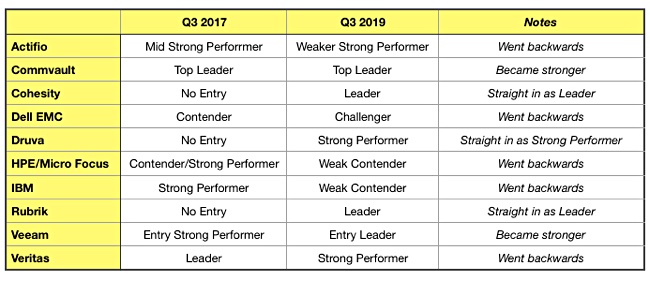Forrester Research has demoted all the legacy vendors except Commvault in a new report that compares the top 10 storage backup and recovery suppliers.
Joining Commvault at the front of the pack are startups Rubrik, Cohesity and Veeam. Veritas has slipped slightly compared with the last outing of Forrester’s report in 2017 while HPE-Micro Focus, IBM and Dell EMC have fallen backwards – with Dell EMC faring worst of all.
The Forrester Wave: Data Resiliency Solutions, Q3 2019 report ranks Commvault, Rubrik, Cohesity, and Veeam as Leaders; Veritas, Druva and Actifio as Strong Performers; IBM and Micro Focus as Contenders; and Dell EMC as a Challenger. Download it here (registration needed.)

Forrester produced a Q3 2017 edition of this report and we have summarised the changes in a table:

Commvault has strengthened its leadership since 2017 and new entrants Cohesity, Druva and Rubrik jump in with strong positions.
This shows how far some legacy players have fallen behind. Forrester argues users need single-pane-of-glass management across all data sources, a comprehensive policy framework, recoverability, and security. The inference is that some legacy vendors are not providing this.
Compared to the Q3 2017 wave, startup Actifio has a weaker placing in the Strong Performer group. The legacy data resiliency players Dell EMC, IBM and Veritas all have weaker placements in the Q3 2019 Wave chart. In fact Forrester says Dell EMC declined to participate in the full Forrester Wave evaluation process.
Give us a Wave
The Forrester Wave is a graphical representation of suppliers in four categories; Challengers, Contenders, Strong Performers and Leaders. They are positioned in a 2D space with a weak-to-strong current offering vertical axis and a weak-to-strong strategy horizontal axis resulting in four quarter circles. Conceptually it is like a Gartner Magic Quadrant; presentationally it is not.
The strongest positions in each segment are closest to the low left-high right diagonal and furthest along it. The chart is part of a report analysing the suppliers’ rankings, using 40 criteria.








